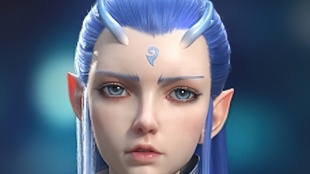您需要 登录 才可以下载或查看,没有账号?注册

x
Introduction
Hi, my name is Christian Mayer and I am currently a student in the Game Artist Program at Vertex School. Before transitioning into 3D environment art, I worked as a Concept Artist in the game industry and have some freelance and in-house experience.
In general, you could say that 3D quickly became an important design tool in most of my concept art workflows from pretty early on. Quick and dirty blockouts in Blender or some basic sculpting in 3DCoat to later be painted over in Photoshop were part of the daily business. I liked exploring any tools that would help me communicate my ideas in a better or more efficient way.
介绍
嗨,我的名字是Christian Mayer,我目前是Vertex学校游戏艺术家计划的学生。在过渡到3D环境艺术之前,我在游戏行业担任概念艺术家,并拥有一些自由职业者和内部经验。
总的来说,你可以说3D从很早开始就迅速成为我大多数概念艺术工作流程中的重要设计工具。Blender中快速而肮脏的块或3DCoat中的一些基本雕刻,后来在Photoshop中绘制,这些都是日常业务的一部分。我喜欢探索任何可以帮助我以更好或更有效的方式传达我的想法的工具。

Now I am shifting to environment art as I wanted to work closer to the product and be part of the immediate player experience. But the same philosophy still stays true for me in creating actual game environments. Getting the idea and story across within the environment is still the main priority to me. And having an eye for composition and style from my design background helps with that. Even though there are undeniable differences that give the created assets a wider range of purposes than just looking good from one specific angle. There are gameplay aspects to deal with, performance, considering different viewing angles, fitting into varying environments. And of course, creating clean geometry, UVs, and textures.
现在,我正在转向环境艺术,因为我想更接近产品,并成为即时玩家体验的一部分。但是,在创建实际游戏环境时,同样的理念仍然适用于我。在环境中传达想法和故事仍然是我的首要任务。从我的设计背景中关注构图和风格有助于这一点。尽管存在不可否认的差异,这些差异使创建的资产具有更广泛的用途,而不仅仅是从一个特定角度看起来不错。有游戏玩法方面需要处理,性能,考虑不同的视角,适应不同的环境。当然,还要创建干净的几何体、UV 和纹理。

Joining Vertex School
In the beginning, I thought I could just go the same route as I did with learning design and drawing. By binging tons of video tutorials and building a foundation by practicing a lot to gain mileage. However, this style of learning didn’t feel sustainable for the course of a longer time period. Finding the balance between assembling a lesson plan for yourself, tutorials, managing your time while trying to stay motivated, staying objective, and continuously making progress was challenging. So I looked for a solution that takes over the organizational part and gives me room to focus on learning. Something that also provides me with all the input I need to stay on course and spend my time efficiently. With Vertex School, I found the right answer to those obstacles.
加入顶点学校
一开始,我认为我可以走与学习设计和绘画相同的路线。通过点击大量的视频教程,并通过练习大量来获得里程来建立基础。然而,这种学习方式在更长的时间内并不可持续。在为自己制定课程计划,教程,管理时间同时努力保持动力,保持客观和不断取得进步之间找到平衡是具有挑战性的。因此,我寻找一种解决方案,接管组织部分,并给我专注于学习的空间。这也为我提供了保持航向和有效利用时间所需的所有输入。在Vertex School,我找到了这些障碍的正确答案。
In the program, students are encouraged to set their own individual goals and explore their ambitions. Yet at the same time, everyone who begins in term 1 starts with learning the same foundation that is necessary for most 3D workflows. When you start studying in terms 2 and 3, students not only choose character or environment art but also decide on what they want to focus on within those fields. With the help of a personal mentor, you have the chance to tailor your portfolio projects towards tech art, material creation, lighting, or anything else that is part of a 3D game pipeline.
在该计划中,鼓励学生设定自己的个人目标并探索自己的抱负。然而,与此同时,每个从第1学期开始的人都会开始学习大多数3D工作流程所需的相同基础。当你开始学习第2学期和第3学期时,学生不仅要选择角色或环境艺术,还要决定他们想在这些领域关注什么。在个人导师的帮助下,您有机会针对技术艺术,材料创作,照明或3D游戏管道中的任何其他内容定制您的投资组合项目。
There is also another quality of Ryan and the Vertex team, specifically as educators, I would like to call attention to, as it boosted my confidence in the decision for Vertex: The emphasis to focus on substance first and technique second. In my opinion, it is difficult to develop your artistic eye by simply following tutorials about workflows and techniques. Consequently, you could miss out on vital aspects that make up good quality assets. Probably everything you produce serves a purpose within a bigger picture. Accurately curating your decisions to fit the frame of that picture often yields more authentic and holistic results. In my experience, this is also true for a lot of other disciplines.
Ryan和Vertex团队的另一个品质,特别是作为教育工作者,我想引起注意,因为它增强了我对Vertex决定的信心:强调首先关注实质,其次是技术。在我看来,仅仅遵循有关工作流程和技术的教程很难发展您的艺术眼光。因此,您可能会错过构成优质资产的重要方面。可能你生产的所有东西都在一个更大的图景中服务于一个目的。准确地策划您的决策以适应该图片的框架通常会产生更真实和全面的结果。根据我的经验,对于许多其他学科也是如此。
The Courtyard Riot Project
A few weeks earlier I was replaying Dishonored 2 which has been a long time coming. I always loved the stylized proportions of the architecture and gritty narrative elements in the game. Therefore, I was inspired to create my own environment within a similar theme and world, including a timeless narrative about ongoing class conflicts and the dark places they can take a society to. So, I started with a simple style guide for my goals in the project and kicked off the research.
庭院防暴项目
几周前,我正在重播《耻辱2》,这已经很久了。我一直很喜欢游戏中风格化的建筑比例和坚毅的叙事元素。因此,我受到启发,在类似的主题和世界中创造自己的环境,包括一个关于持续的阶级冲突和他们可以把社会带到的黑暗地方的永恒叙事。因此,我从一个简单的风格指南开始,为我在项目中的目标设定,然后开始了研究。
While researching I assembled references in a PureRef document, sketched over photos, and created some rough concepts of the ideas in my head, before eventually starting the blockout in Blender. During the blockout phase, I constantly took screenshots, painted over them, or bashed in some photos to get a better grasp on how it should look later on.
Additionally, I needed to find out what kind of pieces I needed to create for the architecture. I ended up going back to the drawing board several times, iterating on important elements during the production later on. Choosing this approach for a portfolio piece with a tight time schedule does of course come with its drawbacks. If you invest too much time in the ideation phase you may find yourself missing out on showcasing other qualities of your environment. For example, some high fidelity materials and sculpts or smart technical systems you came up with.
在研究过程中,我在PureRef文档中收集了参考文献,在照片上绘制了草图,并在脑海中创建了一些粗略的想法概念,然后最终在Blender中开始了封锁。在封锁阶段,我经常截取屏幕截图,在上面画画,或者抨击一些照片,以便更好地掌握它以后应该是什么样子。
此外,我需要找出我需要为架构创建什么样的部分。我最终多次回到绘图板上,在后来的制作过程中迭代了重要元素。为时间表紧迫的投资组合部分选择这种方法当然有其缺点。如果你在构思阶段投入了太多时间,你可能会发现自己错过了展示环境的其他品质。例如,您提出的一些高保真材料和雕塑或智能技术系统。
The Landscape
I created a general layout and the main parts of the architecture in Blender. It was very helpful to create notes and scribbles right on top of the geometry with Blender's Grease Pencil tool. This way I was able to create markers for level design ideas or storytelling elements that are important for the overall narrative right inside the viewport.
景观
我在Blender中创建了一个总体布局和架构的主要部分。使用Blender的Grease Pencil工具在几何体顶部创建笔记和涂鸦是非常有帮助的。通过这种方式,我能够为关卡设计理念或讲故事元素创建标记,这些元素对于视口内的整体叙事非常重要。
After nailing down most of the main shapes and elements in the scene I imported the white boxing into Unreal Engine to replace the pieces one after the other with a modular kit later on.
As the main portion of the level is made out of architectural elements, I focused on adding pieces that allow for variety and can help to prevent too much repetition within the facades of the buildings. The resulting collection of shutters and metal applications also adds more character to the overall look of the scene.
在确定了场景中的大部分主要形状和元素之后,我将白色框导入虚幻引擎,以便稍后用模块化套件一个接一个地替换这些部件。
由于关卡的主要部分由建筑元素组成,因此我专注于添加允许多样性的部分,并有助于防止建筑物立面内出现太多重复。由此产生的百叶窗和金属应用的集合也为场景的整体外观增添了更多特色。
The Statue
The statue was part of the focus areas I wanted to reflect certain emotions and hints towards the underlying narrative of the area. Some propaganda posters that got ripped off in frustration, paint tracks of someone climbing the statue to write messages of defiance or photos of lost loved ones calling attention to the cost of conflict. For this reason, I mainly created 3D assets and decals to serve this purpose.
For the statue, I used a basic character made with the ZBuilder plugin. To find a natural pose I imported the character into Adobe Mixamo. Then I re-imported the geometry back into ZBrush to stylize the shapes a bit and remove the head, making it look like it was vandalized. The rest of the level is mainly filled with assets expressing the functionality of the courtyard and bank which were put into disarray. Benches, lamps, looted locker boxes, etc.
雕像
这座雕像是我想要反映某些情感和对该地区潜在叙事的暗示的重点区域的一部分。一些宣传海报在沮丧中被扯掉,画着有人爬上雕像写下反抗信息的轨迹,或者描绘失去亲人的照片,呼吁人们注意冲突的代价。出于这个原因,我主要创建了3D资产和贴花来实现此目的。
对于雕像,我使用了一个使用ZBuilder插件创建的基本角色。为了找到一个自然的姿势,我将角色导入到Adobe Mixamo中。然后,我将几何图形重新导入到ZBrush中,以对形状进行一些样式化并移除头部,使其看起来像是被破坏了。该楼层的其余部分主要填充了表达庭院和银行功能的资产,这些资产陷入混乱。长凳、灯具、被抢劫的储物柜等
Texturing
For the modular architecture kit, I built a material setup that my Vertex mentor, Stefan Oprisan, suggested to me. This material combines the efficiency of tileable textures with the fidelity of detail masks and vertex painting. It makes use of material variations I created in Substance 3D Designer that blend into each other, a simple stone wall as a base, and then variations with stains or moss, for example. The architecture from the industrial age (the time period I used as reference) was exposed to a lot of pollution. Especially the cavities and convexities were probably filled with soot and other residues. To achieve that look I baked RGB information masks in Substance 3D Painter with variations of ambient occlusion, edge highlights, and gradients to be directly used in the Unreal material.
纹理
对于模块化架构套件,我构建了一个材料设置,这是我的Vertex导师Stefan Oprisan向我推荐的。这种材料将可平铺纹理的效率与细节蒙版和顶点绘画的保真度相结合。它利用了我在Substance 3D Designer中创建的材料变化,这些材料相互融合,以简单的石墙为基础,然后与污渍或苔藓一起变化。工业时代的建筑(我用作参考的时间段)暴露在很多污染中。特别是空腔和凸起可能充满了烟灰和其他残留物。为了实现这种外观,我在Substance 3D Painter中烘焙了RGB信息蒙版,其中包含环境光遮蔽、边缘高光和渐变的变化,以直接在虚幻材质中使用。
Hero assets, like the statue and everything else that is not ground or architecture, were textured uniquely in Substance 3D Painter or got a very simple tiled texture. Generally, I tried to re-use a lot of smart materials in SP to control the material variation. This prevents the level from becoming visually too noisy and keeps everything a bit more grounded and unified within one space.
英雄资产,如雕像和其他所有不是地面或建筑的东西,在Substance 3D Painter中具有独特的纹理,或者获得了非常简单的平铺纹理。通常,我试图在SP中重用许多智能材质来控制材质变化。这可以防止关卡在视觉上变得过于嘈杂,并使所有内容在一个空间内更加接地气和统一。
Assembling the Scene
Everything was assembled in Unreal Engine 5 and the blocking was iterated on by gradually adding asset sets. Not having a fixed concept also came with the benefit of learning to be flexible in decision-making and open to changes. For example, after establishing the architecture I noticed that the buildings still looked a bit too repetitive even though I already created a set of detail assets. So I made a few of the assets broken or bend to block lights with more interesting silhouettes.
Due to time restrictions, only the flying sparks and paper effects were made from scratch with the Niagara System of Unreal. Other effects like the smoke were based 90% on the Unreal Example Assets, Epic provides in their preview levels.
组装场景
所有内容都是在虚幻引擎5中组装的,并通过逐步添加资源集来迭代块。没有一个固定的概念也带来了学习灵活决策和对变化持开放态度的好处。例如,在建立架构后,我注意到即使我已经创建了一组细节资源,建筑物看起来仍然有点过于重复。因此,我用更有趣的轮廓破坏了一些资源或弯曲以阻挡灯光。
由于时间限制,只有飞溅的火花和纸质效果是用虚幻的尼亚加拉系统从头开始制作的。烟雾等其他效果90%基于Epic在其预览关卡中提供的虚幻示例资源。
Lighting in Unreal Engine 5
The lighting technology in UE5 is really powerful and easy to iterate with, therefore I decided to go with a combination of dynamic real-time lights and post-processing. In the beginning, I used Skylight as the fill light in order to fill in the shadows and determine the bottom range for the darkest darks in the scene. Following up with the Directional Light as the key light of the scene, which also generates leading lines with the direction of the resulting shadows. In the next step, the Sky Atmosphere and Height Fog push the mood and realism of the lighting. This also mutes the brightest lights of the scene, generates room in the upper range of the values as well as softens visual edges.
虚幻引擎5中的光照
UE5中的光照技术非常强大且易于迭代,因此我决定将动态实时光照和后期处理相结合。一开始,我使用Skylight作为填充光,以填充阴影并确定场景中最暗的黑暗的底部范围。以定向光作为场景的主光,这也会产生具有所产生阴影方向的前导线。在下一步中,天空氛围和高雾推动了照明的情绪和真实感。这还可以使场景中最亮的灯光静音,在值的上限范围内生成空间,并柔化视觉边缘。
With this more mellow value composition, there is more control to accentuate areas with spotlights and carve out specific shapes. Finally, I used the Post-Processing Volume to achieve a warmer tonality and bring everything together. For this, I graded the scene in Photoshop and brought the LUT back to Unreal. This also helps greatly with the readability of the scene.
通过这种更柔和的价值构图,可以更好地控制用聚光灯突出区域并雕刻出特定的形状。最后,我使用后期处理体积来实现更温暖的色调,并将所有内容组合在一起。为此,我在Photoshop中对场景进行了评分,并将LUT带回了虚幻引擎。这也大大有助于提高场景的可读性。
Conclusion
Designing in parallel to the production was challenging but fun. Nevertheless, the shift from dynamic iterating to efficient planning during this first, bigger environment art project of mine, helped to deliver a fleshed-out result in the end while also meeting the deadline of term 2.
In general, I’m really happy with the overall outcome and am looking forward to term 3 at Vertex School.
结论
与生产并行设计具有挑战性,但很有趣。尽管如此,在我的第一个更大的环境艺术项目中,从动态迭代到高效规划的转变,最终帮助提供了充实的结果,同时也满足了第2学期的最后期限。
总的来说,我对整体结果非常满意,并期待在Vertex学校的第三学期。
|













